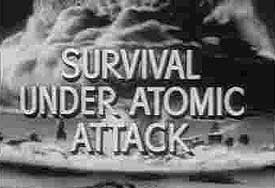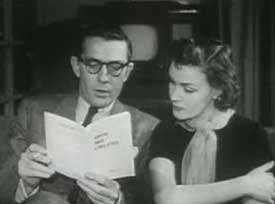 The importance of getting newsmen to voice government propaganda continues when the oh-so-credible authorative voice of Edward R. Morrow narrates Survival Under Atomic Attack (1951), a one-reel government film distributed in 16 mm to highschools, libraries, & to the home-projection market such as thrived in the late 1940s & early 1950s & was the specific market niche of Castle Films.
The importance of getting newsmen to voice government propaganda continues when the oh-so-credible authorative voice of Edward R. Morrow narrates Survival Under Atomic Attack (1951), a one-reel government film distributed in 16 mm to highschools, libraries, & to the home-projection market such as thrived in the late 1940s & early 1950s & was the specific market niche of Castle Films.
The film is based on a government booklet of the same title issued in 1950, a true classic of B-S propaganda, & the pamphlet will be shown in a typical family's possession, though with a simpler cover than the copy shown at the top of this page.
If anyone thought the naivety expressed in the elementary school propaganda film Duck & Cover (1951) was because it was addressed to small children, alas no, Survival Under Atomic Attack expects grown adults of normal intelligence to swallow the same B-S, the main difference being Ed Murrow standing in for the cartoon turtle.
Most of the government films of the era tried to make it look like people wouldn't be all that bad off after the nuclear bombs blew up the cities, but this one is more schizophrenic. It shows, for instance, the completely devastated landscape of Hiroshima. But the remnant of one completely hollowed out buildings & the scanty ruin of another incites a narration is assuring us sturdy buildings will still be standing.
The principle danger will be flying glass & debris. This is a recurring theme in these old propaganda films, that the first minute or so may be just horrifying, but afterward we just have to keep our heads & sweep up.
The script really can't make up its mind whether to admit there's no hope no matter what, or it'll all be fine if we obey the authorities. Contradicting Our Cities Must Fight, it assumes the obvious, that if New York City suffers a nuclear attack, it's all over for New York City. But what about the nice families in the suburbs? What kind of nightmare will be the lot of people beyond the circle of complete anihilation? Why, no nightmare at all!
 People two miles away could be flash-burned "but protection can be easily achieved," Murrow insists on the Duck & Cover principle. Radiation is a secondary problem, but don't worry, for "The majority of people exposed to radiation recovered completely." People two miles away could be flash-burned "but protection can be easily achieved," Murrow insists on the Duck & Cover principle. Radiation is a secondary problem, but don't worry, for "The majority of people exposed to radiation recovered completely."
The use of Japanese film footage is intriguing. An average Japanese family in Hiroshima or Nagasaki eating dinner together during the Occupation shows that even if you're nuked, life can be normal after. It's nice, at least, to think that paranoid & deluded & racist Cold War crazies cared about the Japanese. Most such films assiduously avoid the subject of Hiroshima or Nagasaki, as that reality tended to undermine the message that obedience & preparation & ducking & covering will make it all alright.
The representative American family is nameless, but I think they're the Dobbs's. Bob Dobbs & his wife & kids have prepared their basement as a shelter from the bomb, loading it with canned goods. A big table is required even in the basement, as a place beneath which to duck & cover. Make sure your basement table is big enough for the entire family to duck under.
If you have no basement, use a hallway, & remove mirrors & pictures from the walls of the shelter area. Cleaning the attic is important, too, & keeping the lawn tidy. Keep a bottle of fresh water handy. A radio is vitally important.
When the air raid comes, their little boy is outside dressed as a cowboy shooting his cap pistol. But son, daughter, & Mr. & Mrs. Dobbs quickly close the drapes, turn off the stove burners, disconnect irons & lamps, & hunker down in the basement underneath the table.
"But possibly there may be no time. An attack could come without warning." In that case, we're shown the same array of useless measures that Duck & Cover provided grade-schoolers. If the atomic bomb flashes in the sky, duck in any handy doorway & cover your face, or lay face down beside the street curb, & don't move until you're sure it's safe. Which I suppose could mean don't move ever since you're dead.
Blankets or cardboard are enough to protect you from radioactive fallout. Clean hair & removing all the dirt from under your fingernails is sure-fire defense. The film assumes that after the nuclear holocaust, you can just clean up in the bathroom sink because water will still be running, & then the family can gather around the radio.
Since there'll be no interuption of water & electricity you can probably wile away the hours listening to Amos & Andy or Jack Benny. Stay indoors until Civil Defense says the radiation is gone. Even if it takes ten thousand years?
Murrow ends with a lament that the people of Hiroshima & Nagaski didn't know about these measures.
 Atomic Alert (1951) is a propaganda film aimed at American elemetnary school children, prepared by the University of Chicago's Institute of Nuclear Studies & distributed into the school system by Encyclopaedia Britannica.
Atomic Alert (1951) is a propaganda film aimed at American elemetnary school children, prepared by the University of Chicago's Institute of Nuclear Studies & distributed into the school system by Encyclopaedia Britannica.
Although not admittedly a government film, it follows closely the 1950 propaganda pamphlet posing as useful instructions, Survival Under Atomic Attack. Atomic Alert was obviously made with government funding & oversight, not to mention that the Institute of Nuclear Studies was effectively an extension of the Los Alamos secret labs, & so released nothing to the public without careful auditing by the military.
Children are initially shown in a school room playing with a geiger counter, with scientific narration about radiation. It immediately cuts to "atomic scientists" developing atomic bombs.
The viewing kids are informed by the narrator that they might find themselves in an atomic blast someday, & so here's how they can be totally safe.
First is to hide in the basement. A cross-section of a home is shown with a drawing of a child, all by his lonesome, curled up in a corner of the basement.
 Maybe other kids found that reassuring, but if I'd seen a picture of a kid all alone curled up in the basement trying to survive nuclear holocaust, I'd've had nightmares. Oh wait, I did have nightmares. And you wondered why the boomer generation if so fucking nuts. Maybe other kids found that reassuring, but if I'd seen a picture of a kid all alone curled up in the basement trying to survive nuclear holocaust, I'd've had nightmares. Oh wait, I did have nightmares. And you wondered why the boomer generation if so fucking nuts.
Images of kids running around the streets looking for cover as the air raid siren blairs is pretty scary. Going in strangers' houses is recommended, for as we all know, in times of nuclear warfare all crime stops so it's safe to rely on any random stranger in any random house from whence you might never exit alive anyway.
The "clean, well prepared shelter in the basement" includes a large work-table under which to duck & cover. Little Ted & Sue are shown home alone ducking & covering without reference to parents.
Sue asks Ted what they'd do if they didn't have a basement, which permits this dumbass film to put in Ted's mouth information almost verbatim from that government pamphle, including the advice to lay face-down on the ground if caught out in the open under an atomic blast, & wait one minute. After that one minute you're either already dead or everthing will be dandy.
It builds to children's reenactment of a "real" nuclear attack. The battery radio warns, "Avoid radioactive mist!" & "Don't drink tapwater, it may be contaminated!" At the same time the kids have learned to wash with soap & water to get the radiation off.
Are they supposed use that one pitiful thermos of safe water to wash up? It doesn't say. The main thing is Ted & Sue are safe at home alone thanks due to that basement table.
Given the degree of paranoia in the era, even the kids must've understood all this advice was dumbass. Otherwise the paranoia would've been aleviated. Advice like this made fears worse by making it accidently clear the government & military couldn't do a damn thing.
copyright © by Paghat the Ratgirl
|

